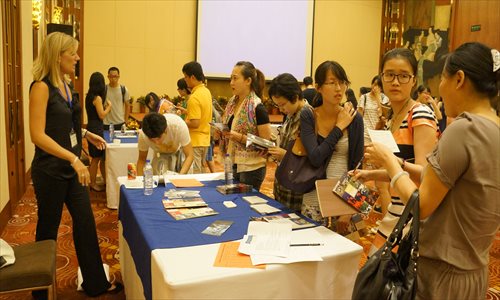Liberal arts pedigree

Universities in the US remain the top choice for Chinese students, but in recent years, liberal arts colleges have overcome their smaller statures and reputations to attract an increasing number of Chinese students.
The China Liberal Arts College Tour, an event which connects liberal arts college admissions officers to prospective students, is seeing more Chinese students from Beijing, Shanghai and Wuhan in Hubei Province interested in these schools.
Xu Yining, one of the organizers of the event, graduated from Grinnell College in Iowa in 2009 and started organizing the tour in 2010.
"We see a gradually increasing number of Chinese people - high school students, parents and high school staff - who are interested in liberal arts colleges," Xu said.
This year, the tour invited 16 colleges, and has received more than 600 online applications for college interviews as of August 3. "The number of applications doubled compared with 2012," Xu said. "2013 is really a big year for us."
Du Yanjing, another organizer of the event, pointed out that Chinese students, parents and advisors were not very familiar with the appeal of a liberal arts education in previous years. "But now their enthusiasm is surprising us," Du said.
"Take Carlton College as an example," Du continued. "It got only 60 applications from the Chinese mainland in 2004, but the number is more than 500 in 2013."
The reason for the recent surge in interest may be in the key differences between liberal arts colleges and bigger universities. The former emphasizes a well-rounded curriculum in the humanities and sciences.
What drew Liu Yijia, a student at Beijing No.4 High School, to liberal arts education was the intimacy and quality of classes. Liu wants to pursue art history at Vassar College in New York, where classes usually have around 10 students and are taught by professors, not postgraduate assistants.
"We can get more teaching resources and engage in more communication with our teachers," said Liu.
In spite of concerns some parents have about the schools being lesser-known and the effect of that on job prospects later down the road, many students pursuing these schools for clear, goal-oriented reasons are able to persuade their parents.
Yu Yibo, another student from Beijing No. 4 High School, told Metropolitan that he is preparing to apply to Kenyon College in Ohio because they have a film studies major and a great football team, but his parents worried about the rank and fame of the college.
"My parents just thought Kenyon is not as famous as Harvard and Yale. So I told them liberal arts colleges and universities are of two different systems, and Kenyon is quite famous in the US," Yu said. "They understood and supported my choice after my explanation."
As these smaller, alternative campuses are now gaining favor with Chinese students and parents, liberal arts colleges are taking note and attaching new importance to the Chinese market.
Dan Lugo, vice president of admissions at Franklin & Marshall College in Pennsylvania, said he values Chinese students as an important part of the college's future. "I see increasing enthusiasm. We weren't so popular three years ago," he said.